I'm trying to create blur effect on a view and than add a shape which will show image on this blurred layer (custom video editing functionality)
Currently I'm able to do it only dragging mask view from the right edge:
but when I try to do it from the left edge, I get such a effect:
func configureBlurView() {
let viewHeight: CGFloat = 60
let padding: CGFloat = 10
blurView = UIView()
blurView.layer.cornerRadius = 10
blurView.clipsToBounds = true
blurView.isHidden = true
blurView.translatesAutoresizingMaskIntoConstraints = false
addSubview(blurView)
addConstraints([
blurView.leadingAnchor.constraint(equalTo: leadingAnchor, constant: padding),
blurView.bottomAnchor.constraint(equalTo: stackView.topAnchor, constant: -padding),
blurView.trailingAnchor.constraint(equalTo: trailingAnchor, constant: -padding),
blurView.heightAnchor.constraint(equalToConstant: viewHeight)
])
addBlurEffect(for: blurView)
}
private func addBlurEffect(for view: UIView) {
let blurEffect = UIVisualEffectView(effect: UIBlurEffect(style: .dark))
blurEffect.alpha = 0.5
blurEffect.translatesAutoresizingMaskIntoConstraints = false
view.addSubview(blurEffect)
addConstraints([
blurEffect.topAnchor.constraint(equalTo: view.topAnchor),
blurEffect.leadingAnchor.constraint(equalTo: view.leadingAnchor),
blurEffect.bottomAnchor.constraint(equalTo: view.bottomAnchor),
blurEffect.trailingAnchor.constraint(equalTo: view.trailingAnchor)
])
}
private func makeClearHole(rect: CGRect) {
let maskLayer = CAShapeLayer()
maskLayer.fillColor = UIColor.black.cgColor
let pathToOverlay = CGMutablePath()
pathToOverlay.addRect(blurView.bounds)
pathToOverlay.addRect(rect)
maskLayer.path = pathToOverlay
maskLayer.fillRule = .evenOdd
maskLayer.cornerRadius = 10
blurView.layer.mask = maskLayer
}
I'm using touchesMoved method to change orange view dimensions:
override func touchesMoved(_ touches: Set<UITouch>, with event: UIEvent?) {
guard trimmerView.isHidden == false else { return }
if let touch = touches.first{
let currentTouchPoint = touch.location(in: self)
let previousTouchPoint = touch.previousLocation(in: self)
let deltaX = currentTouchPoint.x - previousTouchPoint.x
if trimmerView.bounds.width >= 70 {
if touchStartEdge.middle {
if trimmerViewLeadingConstraint.constant < 10 {
trimmerViewLeadingConstraint.constant = 10
} else if trimmerViewTrailingConstraint.constant > -10 {
trimmerViewTrailingConstraint.constant = -10
} else {
trimmerViewLeadingConstraint.constant += deltaX
trimmerViewTrailingConstraint.constant += deltaX
}
}
if touchStartEdge.leftEdge {
if trimmerViewLeadingConstraint.constant >= 10.0 {
trimmerViewLeadingConstraint.constant += deltaX
} else if trimmerViewLeadingConstraint.constant < 10.0 {
trimmerViewLeadingConstraint.constant = 10
}
}
if touchStartEdge.rightEdge {
if trimmerViewTrailingConstraint.constant <= -10 {
trimmerViewTrailingConstraint.constant += deltaX
} else if trimmerViewTrailingConstraint.constant > -10 {
trimmerViewTrailingConstraint.constant = -10.0
}
}
}
updateProgressBarConstraints()
makeClearHole(rect: CGRect(x: 0, y: 0, width: trimmerView.frame.width, height: trimmerView.frame.height))
UIView.animate(withDuration: 0.10, delay: 0, options: .curveEaseIn) { [weak self] in
self?.layoutIfNeeded()
}
}
}
What I'd like to achieve is to remove blur effect only in bounds of orange view.
Any ideas ?? :)
Thanks for help!!





